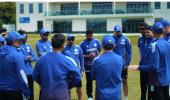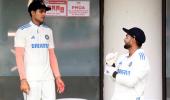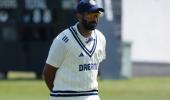If history is anything to go by, Leeds always has room for a little magic.

The Headingley stadium in Leeds is steeped in Britain's cricketing history. It first hosted a Test match way back in 1899 between England and Australia and is home to the Yorkshire County Club, which has produced greats like Herbert Sutcliffe, Len Hutton, Geoff Boycott and Joe Root, while hosting India's finest in Sachin Tendulkar and Cheteshwar Pujara.
The venue has a special place in the memory of English cricket fans. One of their most famous cricketing moments came in the Ashes Test in 1981, when England produced a sensational comeback to clinch victory against Australia.
England, asked to follow on after conceding a 227 run lead, turned the tables on Australia led by Ian Botham's counter-attacking century (149) and a magical performance with the ball by Bob Willis, who took 8/43 to send Australia crashing for 111 as England registered a thrilling 18 run victory despite defending just 130.
India first played at Leeds in 1952 under the captaincy of Vijay Hazare but they suffered a seven wicket defeat despite Vijay Manjrekar's century (133) and Ghulam Ahmed's five-wicket haul in the first innings.
Debutant Yorkshireman Fred Trueman rocked India with the ball, as they slipped to 0/4 in their second innings before finishing on 165 and England easily chased down 125 for victory.
India first tasted victory at this venue 34 years later -- in their fifth attempt -- when Kapil Dev led them to a thumping 279 run victory in the second Test in June 1986. Dilip Vengsarkar starred with the bat for the visitors with brilliant knocks of 61 and 102 -- his second successive century after hitting 126 not out in the first Test at Lord's -- which was also his third century in a row at the Home of Cricket.
They played a match at this venue again after a long gap of 16 years, as the venue didn't host India during the 1990 and 1996 tours.
The 2002 Leeds Test proved to be a turning point in Indian cricket. Traditionally strugglers in seamer-friendly SENA conditions, India thrashed England by an innings and 46 runs -- a landmark triumph that became the catalyst for their rise as a top Test nation. The self-belief gained from that famous win saw India register Test victories away from home on a regular basis.
Captain Sourav Ganguly left everyone shocked when he elected to bat on a green top, having included the spin duo of Anil Kumble and Harbhajan Singh.

Virender Sehwag perished early but Rahul Dravid and Sanjay Bangar battled hard for nearly three sessions on a lively wicket against England's four-man pace attack.
Bangar made a dogged 68 from 236 balls, putting on 170 runs for the second wicket with Dravid, who made a solid 148 to lay the foundation for the middle and lower order.
"The conditions were challenging and the first day wicket was also damp. We (Bangar and Rahul Dravid) took a lot of blows on the body, but we just hung on," Bangar told me in an exclusive interview in 2020.
"We could sense the frustration of the England bowlers who were expecting to roll us over pretty quickly in those seaming conditions. It was about ugly batting in the sense that you played the line, got beaten by late swing, but survived because you did not throw hard hands at the ball."
"I am very proud to be part of that Test win as it is counted by many as among the top Test victories of the Indian team."
After the Bangar-Dravid partnership, Sachin Tendulkar (193) and Ganguly (128) cashed in on the second day when the pitch eased out to power India to a huge 628/8 declared.
Zaheer Khan and Ajit Agarkar took two wickets each while spinners Anil Kumble and Harbhajan picked up three wickets each as England were bowled out for 273. Following on, they were unable to avoid the innings defeat as they were bowled out for 309 despite Captain Nasser Hussain's 110.

But their next Test at Leeds after nearly two decades didn't turn out to expectations. Put into bat, India collapsed for 78 before England amassed a huge 432. Cheteshwar Pujara led a fine fightback with a gutsy knock of 91, while Captain Virat Kohli (55) and Rohit Sharma (59) made half-centuries but couldn't prevent the visitors from going down by an innings and 76 runs.
Overall, India have played seven Tests at Leeds -- winning just two, losing four and one match finished in a draw.
India's Test matches at Leeds
- 1952: India lost by seven wickets
- 1959: India lost by an innings and 173 runs
- 1967: India lost by six wickets
- 1979: Match drawn
- 1986: India won by 279 runs
- 2002: India won by an innings and 46 runs
- 2021: England won by an innings and 76 runs
England have enjoyed a good recent run at Leeds, winning their last five Tests against Pakistan, Australia (twice), India and New Zealand. In the last 10 Tests played at this venue, England have lost only three Tests -- against Sri Lanka (2014), New Zealand (2015) and West Indies (2017).
Dilip Vengsarkar is the top run-getter for India at this venue with 228 runs and Roger Binny the top wicket-taker with seven wickets.
Two decades ago, a bold call by Sourav Ganguly at Leeds rewrote India's overseas Test fortunes. Now, Gill and his youthful squad return to the historic venue, hoping to script a fresh chapter against the same old rivals -- England.
If history is anything to go by, Leeds always has room for a little magic.











